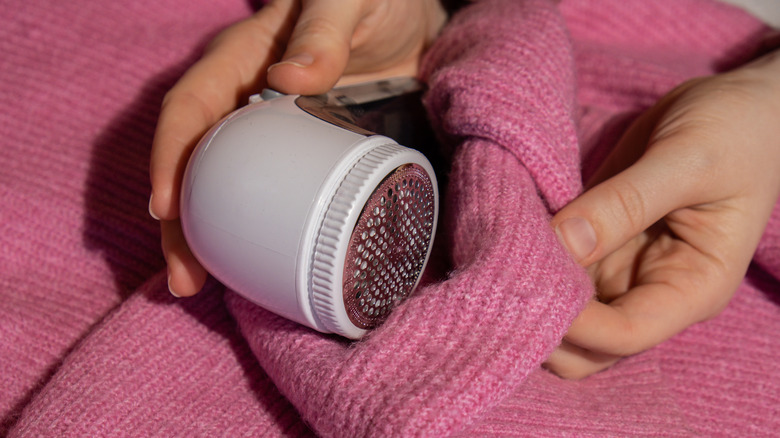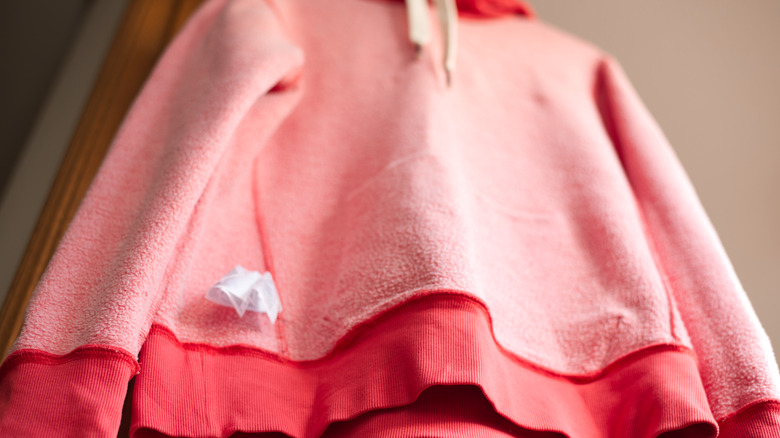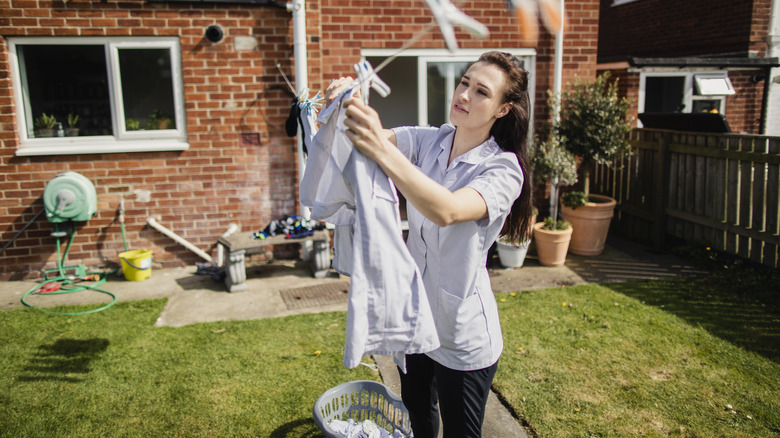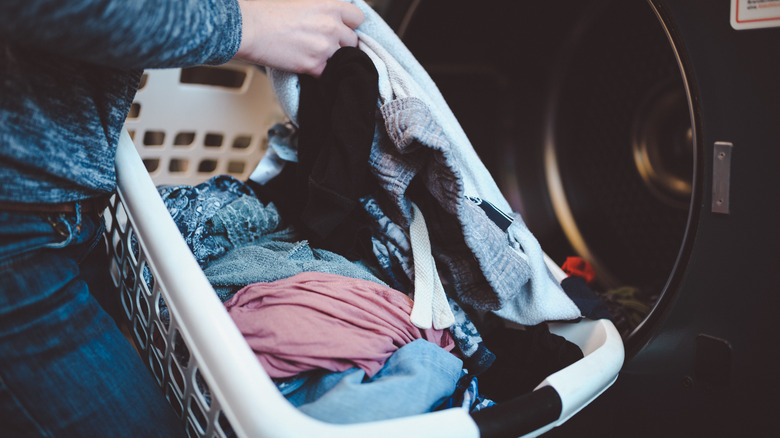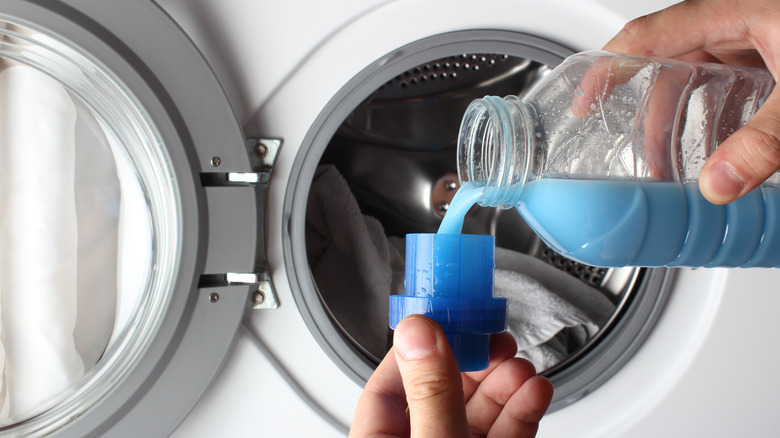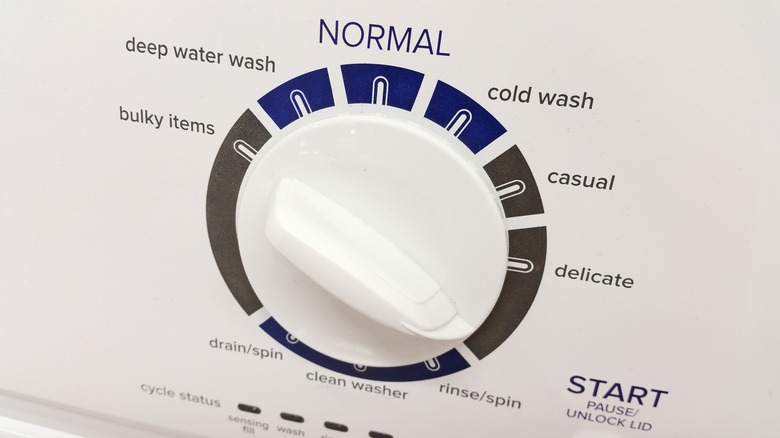What Causes Pilling On Clothing And How Do You Prevent It?
We may receive a commission on purchases made from links.
Have you ever had those tiny little fuzz balls appear on your clothing or blankets after removing them from the dryer? They're called "pills," and although they can cause your fabrics to have an unwanted texture and appearance, there are ways to prevent the process referred to as fabric pilling.
Over time, certain fabrics naturally loosen and stretch, whether it's a shirt, an undergarment, or a dress, which increases the chances of it shifting around when something rubs against it. This friction can be the result of the fabric making contact with another fabric, which happens in the washing machine and dryer. It can even happen when the fabric makes repeated contact with itself, such as the armpit section of a shirt or the crotch section of a pair of pants.
As a result of this friction, the loose fibers can twist into tiny pills on the surface of the material. However, fabric pilling can be prevented by changing how you wash your clothes, and the detergent you use, as well as skipping the dryer entirely. Here's how to prevent it from happening to your beloved pieces.
Turn clothes inside out when washing them
According to Whirlpool, turning a garment inside out before tossing it in the washing machine can prevent pilling on the visible side of the fabric. The interior side can still get pills, of course, since they'll still be prone to friction during the wash and dry cycle, but at least they won't be visible when you wear the garment. This is especially important to do if you're washing other garments together that can't be flipped inside out like blankets or towels.
Washing clothing inside out can be beneficial to the fabric in other ways as well. It can help to preserve the fabric of the garment, making it look newer for longer. It can also protect clothing from damage caused by zippers, buttons, or other hard fasteners or embellishments. These items can easily get caught in pieces of loose fabric on other garments as they rub together in the machine.
Hang dry your laundry
Although having a dryer is a convenient, time-saving component of doing laundry, it's not required. After all, electric clothes dryers have only been around for about 100 years, but people have been washing clothes for centuries. Air drying your laundry is always an option, so if it's a nice sunny day, set out a clothesline. You can also set one inside your home or garage as space allows if you don't want the neighbors to see your laundry.
Hanging your laundry to dry eliminates the friction that would otherwise occur in the dryer, which means you'd be eliminating the risk of dryer-caused fabric pilling. Sure, it's more time-consuming, and you need to be sure you have a clothesline or a rod on hand, but you just may find the means worth the end results. And let's not forget that you can also save money on your utility bill and reduce your carbon footprint.
Limit how often you wash your clothing
Some people do laundry a lot more often than they need to. They will wear an outfit to the office or while running errands and throw it in the hamper at the end of the day to be washed after every single time they wear it. But is washing your clothes after every single wear necessary? If the garment gets soiled or develops an odor, whether it's from sweat or the environment, the answer is obvious, but what if it doesn't?
Perhaps your parents raised you to think clothing is considered "dirty" every time it leaves your body, but according to CNN, experts agree that it's perfectly acceptable to wear certain garments at least a few times before washing them. The less you wash your clothing, the less likely fabric pilling is to occur. You could also hand-wash certain garments or machine-wash similar fabrics together to prevent pilling.
Use fabric softener
Fabric softener does precisely what it says it does, which is soften fabrics during the wash cycle. This softening can prevent pilling by reducing the amount of friction that occurs. Fabric softeners can also help preserve fabrics, prevent static, and keep the fabric from becoming matted. It can even prevent color fading.
The question is, how exactly does fabric softener do all these things? Just as hair conditioner works to smoothen hair with certain ingredients, fabric softener smoothens fabrics. It lubricates clothing and other soft material by attaching a layer of "electrically charged chemical compounds on fabric," as Consumer Reports explains.
Although fabric softener can prevent pilling and present other benefits to clothing, it's not suitable for all fabrics. Martha Stewart warns against it for wool sweaters, cashmere, microfiber, or moisture-wicking garments since it can be damaging to them over time. It can also cause buildup in your washing machine if you use too much of it.
Use the gentle cycle of your washing machine
The gentle or delicate cycle on a washing machine is comparable to hand-washing a garment because it doesn't involve the fast spinning or agitation that a normal cycle does. It's also a shorter cycle than the regular cycle. As a result, friction between fabrics is less likely to occur, which means pilling is less likely to occur.
The temperature of the water can also make a difference for your clothing when you use the delicate cycle. If you use cold water with the delicate cycle, it can provide even more protection against pilling, since cold water is less harsh on fabrics. It can also protect clothes from shrinking, fading, and color transferring, according to GE Appliances.
Some garments may require a gentle cycle anyway to prevent the fabric from getting damaged. Always take the time to check the tag on your clothing and follow the washing instructions.
Use an enzyme-based laundry detergent
In addition to the wash cycle you use, your selected detergent can also play a role in fabric pilling prevention. Whirlpool says that using an enzyme-based detergent in combination with the gentle cycle and cold water will give your clothes twice the protection from pilling. How? By smoothing out the fibers in the fabrics. The smoother the fabric, the less likely it is to pill.
Presto! 96% Biobased Concentrated Liquid Laundry Detergent, Arm & Hammer BioEnzyme Power, Rockin' Green Platinum Series, and Biokleen Natural Cold Water are a few options if you're looking for an enzyme-based laundry detergent.
As an added bonus, enzyme-based detergents are more effective at removing stains and odors than chemical- and soap-based formulas. Plus, the enzymes in these detergents target fibers in clothing in a way that prevents dirt from sticking to the threads. They're also more environmentally friendly than alkaline detergents and don't require hot water to be effective.
